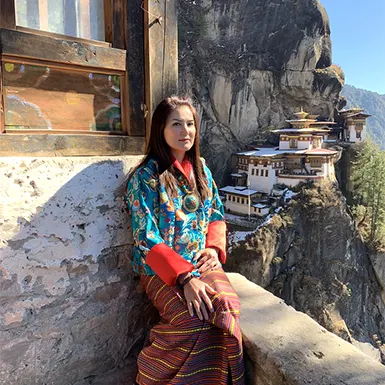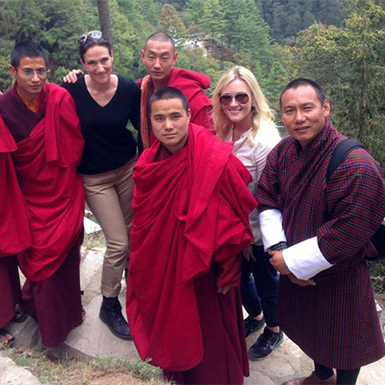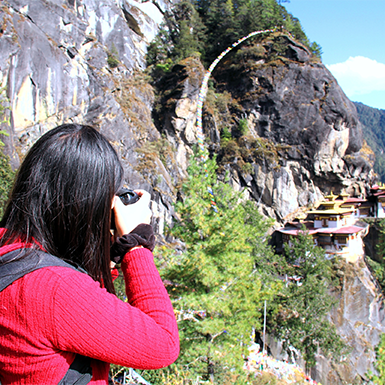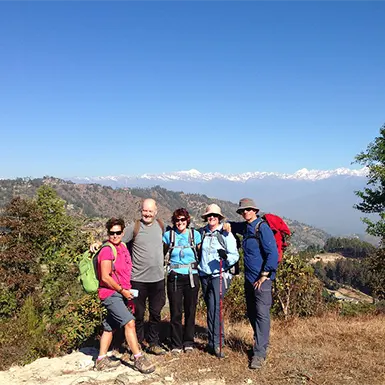In Bhutan’s Paro Valley, Tachogang Lhakhang embodies the nation’s vibrant spiritual heritage and pioneering engineering achievements. Known as the “Temple of the Excellent Horse,” this revered sanctuary attracts global visitors yearning for a profound connection with Bhutanese culture and Buddhism.
The Temple’s Enduring Significance
- Religious Reverence: Tachog Lhakhang commands immense religious devotion from Bhutanese Buddhists. Legend holds that Guru Padmasambhava, the revered figure who brought Buddhism to Bhutan, blessed the temple. Inside, a statue of Chenrezig (Avalokiteshvara), the embodiment of compassion, graces the space alongside cherished relics and texts.
- Cultural Tapestry: The temple seamlessly integrates into Bhutan’s cultural tapestry. It takes center stage during local festivals (tshechu), where monks perform vibrant masked dances and rituals to nurture the well-being of all living beings.
- Engineering Triumph: Beyond its spiritual aura, Tachogang Lhakhang celebrates human ingenuity as an engineering marvel. Thangtong Gyalpo, the renowned bridge builder, constructed the temple in the 15th century. It boasts an iron chain suspension bridge—an innovation that pushed the boundaries of its era.

Exploring the Temple’s Enchanting Complex
Crossing the ancient iron bridge transports you into a captivating realm of tranquility and scenic beauty within the temple complex.
- Main Shrine (Lhakhang): At the heart of the complex, this shrine shelters revered statues and relics, most notably the image of Chenrezig.
- Kangyur and Tengyur: The temple safeguards a collection of these ancient Buddhist texts, treasured as some of the most important scriptures in Mahayana Buddhism.
- Thangtong Gyalpo’s Legacy: Visitors may encounter a walking stick or other artifacts that once belonged to the legendary bridge-builder himself.
The Tale of Tachogang Lhakhang: A Tapestry of History and Legend
Tachogang Lhakhang is a unique temple. Instead, it is an Amazing account of the Bhutanese past, faith, and construction skills. A mix of factual information and myths created it.
The Visionary Founder: Thangtong Gyalpo, the Iron Bridge Builder
The temple owes its existence to the extraordinary Thangtong Gyalpo (1385-1464), a revered figure in Bhutanese history. People often called him the “Iron Bridge Builder” because he was a brilliant engineer, yogi, and spiritual leader. According to legend, Thangtong Gyalpo received a divine vision instructing him to build a temple at the very spot where a horse’s head (tacho) had miraculously emerged from the earth. This event inspired the temple’s name, Tachogang, which translates to “Temple of the Excellent Horse.”
Thangtong Gyalpo was not just a visionary but a master of innovation. He constructed more than 58 iron chain suspension bridges across Bhutan and Tibet, transforming regional travel and trade. The iconic iron bridge at Tachogang is a testament to his engineering genius.
Historical Milestones of Tachogang Lhakhang
- 15th Century: Foundation and Construction: In the 15th century, Thangtong Gyalpo laid the foundation of Tachogang Lhakhang. The temple’s construction combined traditional Bhutanese architecture with Thangtong Gyalpo’s unique engineering skills.
- Spiritual Significance: Over the centuries, the temple gained immense religious importance. It became a revered pilgrimage site for Bhutanese Buddhists and a center for Buddhist learning and practice.
- Cultural Hub: It became a focal point for local cultural traditions. The temple hosted vibrant festivals, where the community gathered to celebrate and express their faith through masked dances, music, and rituals.
- Modern Preservation: Today, it is a well-preserved monument to Bhutan’s rich history and cultural heritage. It continues to be an active place of worship, a tourist attraction, and a source of inspiration for visitors.

The Architectural Splendor: A Fusion of Artistry and Innovation
Tachogang Lhakhang isn’t merely a place of worship; it’s a living testament to Bhutanese architectural mastery, seamlessly blending artistic expression with engineering innovation.
Distinctive Architectural Elements
- Traditional Bhutanese Style: The temple complex embodies conventional architecture with intricate woodwork, vividly colored murals, and sloping roofs adorned with gleaming golden finials.
- Multi-Storied Sanctuary: The main shrine (Lhakhang) features multiple stories, each housing sacred relics, statues, and religious texts. The layout invites visitors to ascend through the levels, symbolizing a spiritual discovery tour.
- Courtyard and Gardens: A tranquil courtyard encircles the main shrine, offering a serene space for quiet reflection and prayer. Lush gardens, vibrant with colorful flowers and prayer flags, enhance the peaceful ambiance.
Treasures Within the Temple Walls
- Statue of Chenrezig: The temple’s inner sanctum houses a magnificent statue of Chenrezig (Avalokiteshvara), the embodiment of compassion, adorned with intricate details and precious stones.
- Sacred Murals: Vibrant murals depicting scenes from the life of Buddha, Buddhist deities, and significant historical figures adorn the temple walls. These murals offer valuable insights into Bhutanese religious beliefs and cultural narratives.
- Kangyur and Tengyur: Tachog Lhakhang safeguards a collection of the Kangyur and Tengyur, ancient Buddhist scriptures that form the foundation of Mahayana Buddhism. People consider these texts national treasures, preserving centuries of wisdom.
The Iron Chain Bridge: A Symbol of Innovation
A defining feature of Tachogang Lhakhang is its iron chain suspension bridge. Built by Thangtong Gyalpo in the 15th century, this bridge was a pioneering feat of engineering for its time. It served as a vital connection across the Paro Chhu River and a testament to Thangtong Gyalpo’s ingenuity and dedication to improving the lives of the Bhutanese people.
The bridge is not merely a functional crossing; it’s a symbol of physical and spiritual connection. Crossing the bridge evokes a sense of awe and wonder at the engineering prowess of the past and the enduring power of human innovation.
Tachogang Lhakhang: A Beacon of Bhutanese Buddhism
Beyond its architectural and historical allure, Tachogang Lhakhang thrives as a vibrant center of Bhutanese Buddhist faith and practice. Its spiritual importance resonates deeply with locals and pilgrims alike.
Spiritual Significance and Rituals
- A Sacred Sanctuary: It serves as a sacred sanctuary for locals and visitors seeking solace and spiritual connection. It offers a serene environment for meditation, prayer, and reflection.
- Daily Rituals: The temple’s resident monks maintain disciplined daily prayers, chanting, and meditation routines, which create a palpable serenity and devotion within the temple complex.
- Religious Ceremonies: Throughout the year, the monks perform various religious ceremonies and rituals, many of which are open to the public. These ceremonies provide a unique chance to experience the rich traditions of Bhutanese Buddhism.
Vibrant Festivals at Tachogang Lhakhang
- Tshechu: The temple’s annual tshechu, or religious festival, is a significant highlight. It features vibrant masked dances performed by monks, conveying a spiritual message or story. The tshechu attracts locals from surrounding villages and visitors from around the world.
- Other Celebrations: In addition to the main tshechu, Tachogang hosts smaller festivals and events throughout the year, marking essential dates in the Buddhist calendar.
A Glimpse into Monastic Life
The monks residing at Tachogang Lhakhang lead a simple and disciplined life dedicated to their spiritual practice and preserving Bhutan’s religious heritage. Visitors are often welcome to observe the monks’ daily routines, which may include:
- Morning Prayers: The day begins with early morning prayers and chanting in the main shrine.
- Study and Meditation: Monks dedicate much time to studying Buddhist scriptures and practicing meditation.
- Community Service: Many monks also participate in community service activities, such as teaching, offering blessings, and providing spiritual guidance.

Discovering Tachogang Lhakhang: A Scenic Path
Tucked away in the breathtaking Paro Valley, Tachogang Lhakhang invites you to explore its rich history and cultural significance. The trip to this historic temple is a scenic adventure through Bhutan’s natural beauty.
Where to Find It
- A Stone’s Throw from Paro: Tachog Lhakhang is conveniently situated 5 kilometers (3 miles) north of the bustling Paro town, the heart of the enchanting Paro Valley.
- Nestled in Nature: Perched on a hill overlooking the tranquil Paro Chhu (river), the temple is enveloped in lush greenery and surrounded by traditional Bhutanese villages, creating a picturesque scene.
Your Route to Tachogang Lhakhang
- Effortless Taxi Ride: Hop into a taxi for a quick and comfortable tour from Paro town. The ride to Tachog Lhakhang usually takes 15-20 minutes.
- Scenic Drive: If you crave flexibility, rent a private car with a driver and enjoy a leisurely drive to the temple.
- Invigorating Hike: Adventurous souls can embrace the scenic 1-2 hour hike from Paro town, soaking in the breathtaking valley and countryside views.
- Guided Tour: For a hassle-free experience, choose a guided tour from one of Paro’s many tour operators. These tours often combine Tachogang with other captivating attractions in the valley, and a knowledgeable guide will share fascinating insights about the temple’s history and significance.
Navigating the Path
- Crossing the Iron Bridge: To reach the temple, you’ll traverse the iconic iron chain suspension bridge, a testament to Bhutan’s ingenuity. While the bridge is sturdy and well-maintained, those fearing heights might find it thrilling. However, the panoramic views from the bridge are simply awe-inspiring.
- A Gentle Stroll to the Temple: Once you cross the bridge, a short, well-kept path leads uphill to the temple complex. The walk is relatively easy, but we recommend wearing comfortable walking shoes.
Must-See Attractions Near Tachogang Lhakhang
- Rinpung Dzong (Paro Dzong): This grand fortress and monastery showcases exquisite Bhutanese architecture. Wander through Rinpung Dzong courtyards, admire its temples, and delve into its administrative offices. If your timing aligns, witness the vibrant Paro Tshechu festival, a spectacle of color and tradition.
- National Museum of Bhutan (Ta Dzong): Perched in a former watchtower, this museum unveils Bhutan’s captivating history, art, and culture. Marvel at its collection of religious artifacts, intricate textiles, and detailed thangkas (religious paintings).
- Kyichu Lhakhang: Travel back in time to Kyichu Lhakhang, one of Bhutan’s oldest and most sacred shrines. Historians believe the construction of Kyichu Lhakhang dates back to the 7th century. A serene environment and beautiful murals are the backdrop for a peaceful place.
- Paro Taktsang (Tiger’s Nest Monastery): Venture further to this iconic monastery, precariously clinging to a cliffside with breathtaking. The challenging hike rewards you with an unforgettable experience.
- Drukgyel Dzong: Discover the ruins of Drukgyel Dzong, a historic fortress that once was crucial in protecting Bhutan from Tibetan invasions. The surrounding landscape unveils panoramic vistas.
Crafting Your Paro Valley Itinerary
Here are two sample itineraries that seamlessly incorporate Tachogang Lhakhang into your exploration:
1. A Day of Cultural Immersion:
- Morning: Start your day with a visit to Tachogang Lhakhang, delving into its spiritual and historical significance. Cross the iron bridge and explore the temple complex at your own pace.
- Afternoon: Visit Rinpung Dzong, where you can admire its majestic architecture and rich history. Then, visit the National Museum to enrich your understanding of Bhutanese culture.
- Evening: Wander through Paro town’s charming streets, discover unique handicrafts and souvenirs in local shops, and savor a traditional Bhutanese dinner.
2. Nature and Spirituality Trek:
- Morning: Hike from Paro town to Tachog Lhakhang and enjoy the valley’s scenic beauty.
- Afternoon: Find tranquility at Kyichu Lhakhang, appreciating its serene atmosphere and ancient murals.
- The Following Day: Take the challenging yet rewarding hike to the iconic Paro Taktsang (Tiger’s Nest Monastery), where breathtaking views greet you.
Planning Your Trip to Tachogang Lhakhang: Essential Tips for a Fulfilling Visit
Adequate preparation ensures you maximize your time at this revered site, offering a unique cultural and spiritual experience.
When to Visit: Bhutan’s Seasons and Tachogang Lhakhang
- Spring (March-May): A popular time to visit, with pleasant temperatures, blooming rhododendrons, and clear skies.
- Autumn (September-November): Autumn (September-November) is another ideal time to visit Tachogang, as it offers crisp air, vibrant foliage, and comfortable temperatures.
- Summer (June-August): While the monsoon season brings rain, it also creates lush landscapes. Fewer tourists make it a more tranquil time to explore.
- Winter (December-February): Chilly but sunny days offer stunning views of snow-capped mountains. Fewer crowds also mean a more intimate experience at the temple.
What to Wear and Pack
- Respectful Attire: As Tachogang Lhakhang is a sacred site, dress modestly. Avoid shorts, sleeveless tops, or revealing clothing. We recommend wearing long pants or skirts and shirts with sleeves.
- Comfortable Shoes: You’ll walk on uneven terrain and cross a suspension bridge, so wear sturdy, comfortable footwear.
- Sun Protection: Even on cloudy days, the high altitude can intensify the sun: pack sunscreen, a hat, and sunglasses.
- Rain Gear: During the monsoon season, bringing a raincoat or umbrella in anticipation of rain is advisable.
- Camera: Capture the beauty of the temple and its surroundings, but remember to ask for permission before taking photos inside the main shrine.
- Water and Snacks: Carry a water bottle and some snacks, especially if you’re hiking to the temple.
- Small Backpack: A small backpack is handy for carrying your essentials.
Cultural Etiquette
- Show Respect: Remove your shoes before entering the temple’s central shrine.
- Mindful Photography: Always seek permission before photographing people, particularly monks.
- Maintain Silence: Keep your voice low and avoid loud conversations within the temple complex.
- Offerings: When visiting temples in Bhutan, making a small offering of money or butter lamps is customary.
- Follow Instructions: The monks may have specific guidelines for visitors, so observe them.
Responsible Tourism
- Preserve the Environment: Take your trash with you and avoid littering.
- Support Local Communities: Purchase handicrafts and souvenirs to support artisans’ livelihoods in the Paro Valley.
- Learn a Few Phrases: A few basic Dzongkha phrases, like “kuzuzangpo” (hello) and “kadrinche” (thank you), go a long way toward showing respect for the local culture.
Personal Encounters with Bhutan’s Spiritual Heart
The magic of Tachogang Lhakhang extends beyond its physical beauty and historical significance. It touches the hearts and souls of those who visit, leaving lasting impressions and cherished memories.
Testimonials and Reflections
“Crossing the iron bridge felt like stepping back in time. The serenity of the temple grounds enveloped me, and the sound of the monks’ chanting filled the air. It was a truly spiritual experience.” – Sarah L., Canada.
“The vibrant murals inside Tachog Lhakhang told stories of Bhutan’s rich history and beliefs. I felt a deep connection to the culture and the people.” – Tenzin D., Bhutan.
“As a photographer, I was captivated by the intricate details of the temple’s architecture and the vibrant colors of the prayer flags. But the peaceful atmosphere stayed with me long after I left.” – Kenji T., Japan.
“My visit to Tachogang Lhakhang was a highlight of my trip to Bhutan. The temple’s unique blend of history, engineering, and spirituality left me in awe.” – Maria S., Spain.
A Shared Sentiment
While the specific experiences vary, a common thread weaves through the stories of those who have visited Tachog Lhakhang. The temple can inspire awe, foster connection, and ignite a deeper appreciation for Bhutan’s rich cultural heritage.
The Essence of Tachogang Lhakhang
The tranquility of the surroundings, the vibrant colors of the murals, and the warmth of the local people leave an indelible mark on the hearts of those who visit this sacred site. It is a place where the past and present intertwine, offering a glimpse into the heart of Bhutan’s spiritual traditions.
The Timeless Allure of Tachogang Lhakhang: A Must-Visit Destination in Bhutan
Tachogang Lhakhang is a treasure trove of Bhutanese heritage. It seamlessly blends spirituality, history, and engineering marvels into a captivating destination.
In Summary
- Spiritual Haven: This sacred temple is a beacon of Bhutanese Buddhism, offering a tranquil space for reflection and prayer.
- Engineering Marvel: The iconic iron chain suspension bridge, a testament to Thangtong Gyalpo’s ingenuity, invites you to step back in time.
- Cultural Gem: Explore the temple’s intricate architecture, vibrant murals, and sacred relics, each telling a story of Bhutan’s rich past.
- Scenic Setting: It offers spiritual enrichment and natural beauty in the picturesque Paro Valley.
Your Invitation to Tachogang Lhakhang
Whether you seek spiritual solace, a glimpse into Bhutanese history, or an appreciation for architectural innovation, Tachogang awaits. It’s a place where the past and present intertwine, offering a unique experience that will resonate long after you leave. Plan your visit to Tachogang Lhakhang and discover the magic that awaits you in this spiritual and cultural haven.









